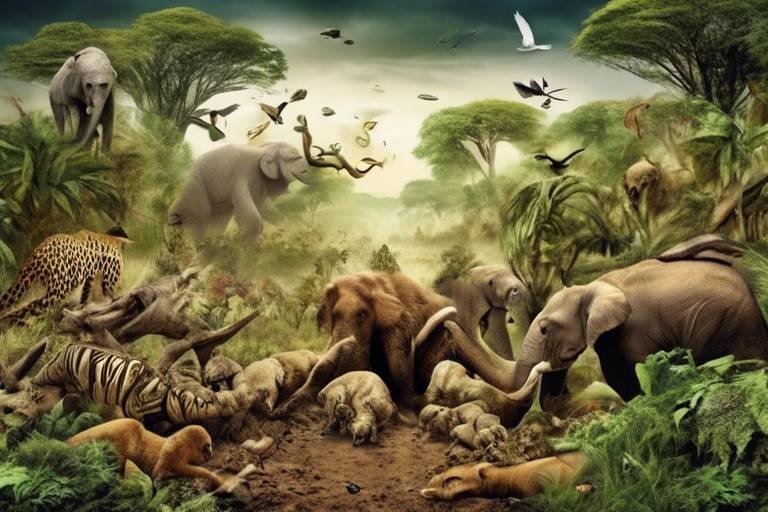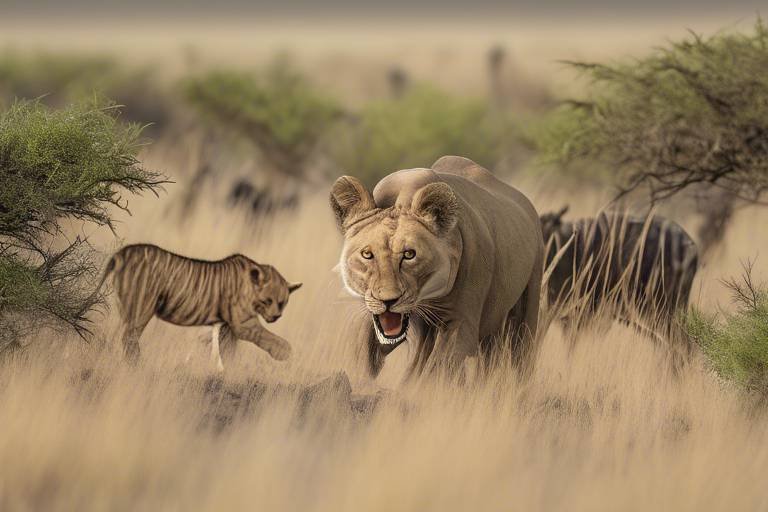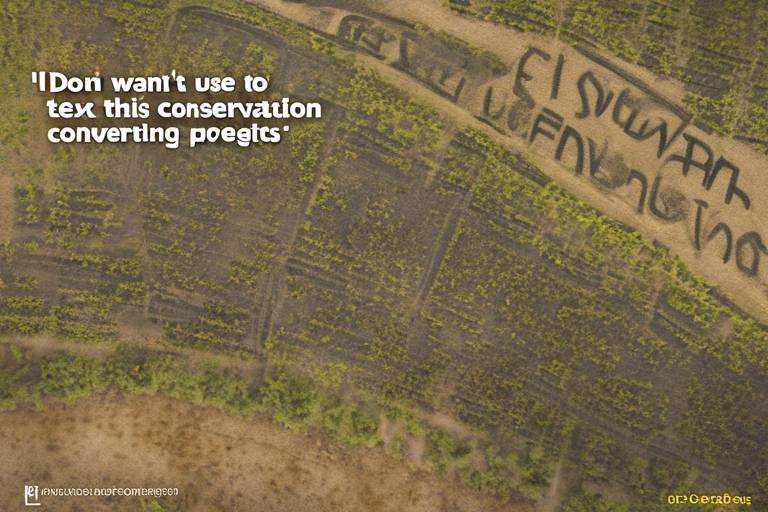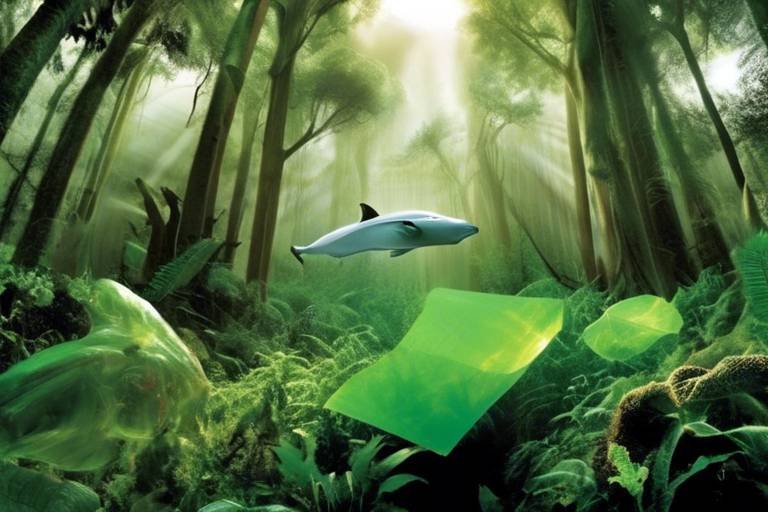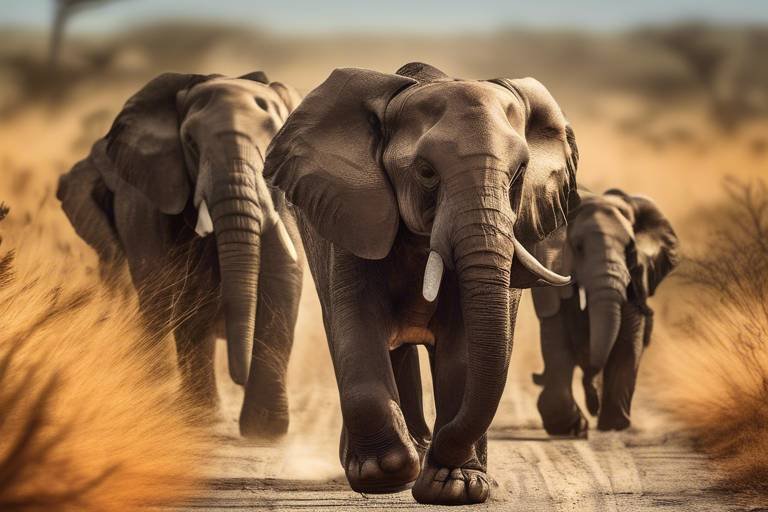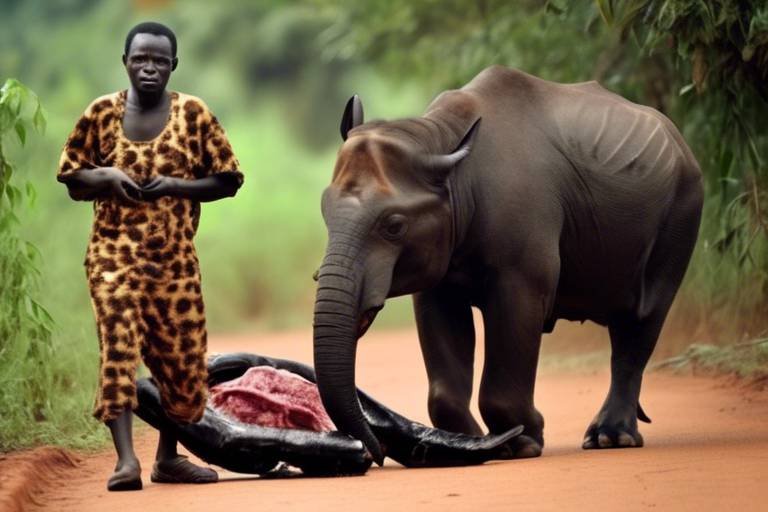Friend or Foe: Animals in Pop Culture and their Real Life Counterparts
When we think of animals in pop culture, our minds often drift to the larger-than-life characters that grace our screens, books, and games. From the loyal dog in a heartwarming film to the ferocious dragon in a fantasy epic, these portrayals can evoke a range of emotions and thoughts. But how do these fictional representations stack up against their real-life counterparts? Are they truly friends, or do they sometimes play the role of a foe? In this exploration, we will dive into the fascinating world of animals in pop culture, contrasting their charming or fearsome depictions with the often surprising realities of their behaviors, roles, and significance in our society.
Consider the iconic character of Simba from Disney's "The Lion King." This lovable lion embodies courage, friendship, and the struggle for identity. Yet, in the wild, lions are complex creatures with intricate social structures, often characterized by fierce competition and survival instincts. The film presents a heartwarming narrative that resonates with audiences, but it glosses over the harsh realities of life in the animal kingdom. Similarly, characters like Shrek's Donkey or Finding Nemo's Dory charm us with their quirks and humor, yet their real-life counterparts often face challenges such as habitat loss and environmental threats. These portrayals can create a disconnect, leading us to view these animals through a romanticized lens rather than understanding their true nature.
Mythical creatures have long captivated our imaginations, often drawing inspiration from the fascinating traits of real animals. The origins of these fantastical beings reveal much about human culture and our relationship with the natural world. For instance, dragons—those magnificent, fire-breathing beasts—are not merely figments of our imagination; they are deeply rooted in the characteristics of various real animals. By examining these connections, we can appreciate how our stories and myths reflect our understanding of the animal kingdom.
Dragons have been a staple of mythology across cultures, captivating audiences with their power and mystery. But what lies behind these legendary creatures? Are they merely products of human creativity? Or do they have real-life inspirations? The truth is, many dragons share traits with reptiles, particularly in their physical attributes and behaviors. This exploration will take us on a journey through the fascinating world of reptilian inspirations behind these mythical beings.
When we think of dragons, it’s hard not to draw parallels with reptiles like crocodiles and monitor lizards. These creatures exhibit some of the same fierce characteristics attributed to dragons, such as powerful jaws and formidable hunting skills. For instance, the Komodo dragon, a species of monitor lizard, showcases a blend of fearsome appearance and predatory prowess, which may have influenced dragon myths. The similarities in their physical traits, such as scaly skin and elongated bodies, help to bridge the gap between reality and fantasy, making dragons feel more relatable, yet still otherworldly.
Interestingly, some dragon legends may have avian origins. Large birds of prey, like eagles and condors, often exhibit behaviors and features that resemble those attributed to dragons. Their majestic wingspans and fierce hunting techniques can easily inspire tales of flying serpents and fire-breathing beasts. This connection highlights how our fascination with the natural world can lead to the creation of myths that reflect our awe and respect for these magnificent creatures.
Fictional pets hold a special place in our hearts, often serving as loyal companions to their human counterparts in stories. Characters like Hedwig from "Harry Potter" or Garfield the cat demonstrate how animals can embody traits that resonate with us. Yet, while these pets may be endearing and relatable, they often distort the behaviors of real-life animals. For example, while Hedwig is portrayed as a wise and loyal owl, real owls are solitary creatures that don’t typically form such bonds with humans. This discrepancy invites us to question how much of these portrayals reflect reality and how much is purely for entertainment.
In the realm of video games, animals take on a variety of roles, from fierce foes to beloved companions. They enrich gameplay and storytelling, making our virtual experiences more immersive. Whether it's the adorable fox in "Spirit of the Wild" or the menacing wolves in "The Last of Us," animals in games often reflect their real-life counterparts while also serving specific narrative purposes. This duality raises interesting discussions about how we perceive animals in both digital and real-world contexts.
Companion animals in video games often enhance the player's experience, creating emotional connections that can rival those we have with real pets. Games like "The Legend of Zelda: Breath of the Wild" feature companions that not only assist players in their journey but also evoke feelings of loyalty and friendship. These virtual pets can mirror the joy and companionship we experience with real animals, showcasing the profound impact that animals—real or fictional—have on our lives.
However, the portrayal of wildlife in video games can vary significantly. While some games strive for realism, others take creative liberties that can lead to misconceptions about animal behaviors and habitats. It's crucial for players to recognize these differences and understand that while these representations can be entertaining, they may not always reflect the true nature of wildlife. Acknowledging this distinction allows us to appreciate the artistry behind game design while also fostering a deeper respect for the real animals that inspire these characters.
- Why are animals portrayed differently in pop culture compared to real life? Animals in pop culture are often anthropomorphized to evoke emotions and connect with audiences, leading to portrayals that may not accurately reflect their real behaviors.
- What are some examples of animals that have mythical counterparts? Dragons, griffins, and unicorns are all examples of mythical creatures that have roots in real animals, showcasing how human imagination can transform reality into fantasy.
- How do video games influence our perception of animals? Video games can shape our understanding of animals by highlighting their traits and behaviors, but they may also distort reality, leading to misconceptions about wildlife.

Iconic Animal Characters in Film
When we think about iconic animal characters in film, a vivid tapestry of personalities and adventures springs to mind. These characters often resonate with us on a deeply emotional level, transcending the screen to become symbols of friendship, courage, and sometimes, mischief. From the adventurous Simba in "The Lion King" to the loyal Hooch in "Turner & Hooch," animals in films are not just sidekicks; they often drive the plot and evoke strong feelings in viewers. Their portrayal can range from heroic and wise to silly and playful, reflecting a wide spectrum of traits that mirror our own human experiences.
Take Shrek's sidekick, Donkey, for example. Voiced by the ever-energetic Eddie Murphy, Donkey is a character who embodies the essence of friendship and loyalty, often providing comic relief while also supporting Shrek through his journey of self-discovery. This dynamic showcases how animals can serve as catalysts for character development, pushing the main characters to confront their fears and insecurities. Similarly, in "Finding Nemo," the character of Dory—a regal blue tang fish—teaches us about perseverance and the importance of memory, even when faced with challenges. The emotional depth these characters bring is a testament to the skillful storytelling that goes into creating them.
Moreover, the impact of these characters extends beyond the screen. They often become cultural phenomena, spawning merchandise, spin-offs, and even dedicated fan bases. Consider Hedwig, Harry Potter's loyal owl, who not only serves as a mode of communication but also symbolizes the bond between Harry and the magical world. The connection fans feel with such characters can lead to a deeper understanding of real-life animals and their roles in our ecosystem. In this way, films can educate audiences about animal behavior and conservation, making them more aware of the challenges faced by real animals in our world.
Additionally, the portrayal of animals in films often reflects societal values and norms. For instance, the character of Baloo from "The Jungle Book" represents a carefree spirit and the importance of friendship, which resonates with audiences of all ages. His laid-back attitude and nurturing nature offer a contrast to the more serious characters in the story, reminding viewers of the value of enjoying life. On the other hand, films like "Zootopia" tackle complex themes such as prejudice and acceptance through anthropomorphized animals, providing a platform for discussions about societal issues.
In conclusion, the portrayal of iconic animal characters in film is a multifaceted phenomenon that not only entertains but also educates and inspires. These characters become more than just fictional beings; they embody traits and lessons that resonate with audiences, encouraging reflection on our relationships with each other and with the natural world. As we continue to see these characters evolve in cinema, one can only wonder what new lessons and adventures await us in the future.

Mythical Creatures vs. Real Animals
When we think of mythical creatures, our minds often wander to fantastical beings that defy the laws of nature, captivating our imaginations with their extraordinary powers and unique traits. But where do these legends come from? In many cases, they are deeply rooted in the characteristics of real animals that have roamed the Earth. This connection between myth and reality not only enriches our understanding of these creatures but also highlights the ways in which human culture has interpreted the natural world. From the majestic dragon to the elusive unicorn, let's dive into the fascinating world where mythical creatures and their real-life counterparts collide.
One of the most prominent examples of this connection is the legendary dragon. These magnificent beasts are often depicted as fire-breathing reptiles, soaring through the skies with grace and ferocity. But what inspired such a powerful image? Many scholars argue that dragons were influenced by the observation of real reptiles, particularly those that exhibit fierce behaviors and impressive physical traits. For instance, the size and strength of crocodiles, combined with the stealth of monitor lizards, may have contributed to the dragon's fearsome reputation in folklore. The dragon symbolizes not only danger but also wisdom and strength, making it a complex figure in various cultures.
Throughout history, dragons have been portrayed in countless ways, from the benevolent guardians of treasure to the terrifying beasts that threaten villages. This duality reflects the human experience with nature—both reverence and fear. In many cultures, dragons are seen as protectors, embodying the spirit of the land. In contrast, their destructive capabilities often mirror the unpredictable aspects of nature, such as storms or earthquakes. This juxtaposition of traits serves to remind us of the delicate balance between humanity and the wild, a theme that resonates throughout many stories.
As we explore the reptilian inspirations behind dragons, it's fascinating to note that many cultures have drawn parallels between these mythical creatures and real reptiles. For example, the Komodo dragon, with its formidable size and predatory nature, shares a name and some characteristics with its mythical counterpart. The Komodo dragon is known for its powerful bite and venomous saliva, making it a modern-day representation of the fearsome dragon of lore. Similarly, the alligator's stealth and strength evoke the same sense of awe and trepidation that dragons do in stories.
Interestingly, some dragon legends also have avian origins. Large birds of prey, such as eagles and vultures, possess majestic wingspans and hunting prowess that could easily fuel the imagination of ancient storytellers. The way these birds soar through the sky, combined with their sharp talons and keen eyesight, may have inspired myths of dragons that dominate the skies. In many cultures, the dragon is depicted with features reminiscent of birds, such as feathers or wings, further blurring the lines between reality and fantasy.
As we unravel the threads connecting mythical creatures to their real-life inspirations, it's clear that these stories serve a purpose beyond mere entertainment. They reflect our understanding of nature, our fears, and our aspirations. By examining the origins of these legends, we gain insight into how humans have historically interacted with the animal kingdom, often attributing human-like traits to creatures that inspire both wonder and respect.
- What are some examples of mythical creatures inspired by real animals?
Many mythical creatures, like the griffin (a combination of a lion and an eagle) and the mermaid (often linked to fish and aquatic mammals), draw inspiration from real animals. These hybrids showcase the fascinating ways cultures have blended traits from different species to create new legends. - How do mythical creatures reflect human culture?
Mythical creatures often embody human values, fears, and aspirations. For instance, dragons can symbolize strength and wisdom, while unicorns represent purity and grace. These traits resonate with cultural ideals, making the creatures relatable to people across different societies. - Are there any real animals that resemble mythical creatures?
Yes! Animals like the okapi, which has features reminiscent of both a horse and a zebra, or the axolotl, known for its unique appearance and regenerative abilities, can seem quite mythical in their own right.

Dragons: Legends and Reality
Dragons, the magnificent and terrifying creatures of lore, have captured the human imagination for centuries. Their presence in myths, films, and literature is as potent as the fire they are said to breathe. But have you ever wondered where these legendary beasts come from? What inspired the tales of their grandeur and ferocity? In this exploration, we delve into the fascinating world of dragons, contrasting their mythical representations with the real-life animals that may have inspired them. The allure of dragons often lies in their incredible abilities—flight, fire-breathing, and immense size—qualities that set them apart from the mundane creatures of our world.
Interestingly, many of the traits attributed to dragons can be traced back to real animals, particularly reptiles. For example, the image of a dragon soaring through the skies with its scaled body and sharp claws might remind you of some of the largest reptiles we know today. The Komodo dragon, a large lizard native to Indonesia, embodies some of these features. With its formidable size and predatory nature, it’s easy to see how such a creature could inspire tales of fire-breathing beasts. Additionally, the crocodile—with its armored skin and powerful jaws—could easily morph into a dragon in the minds of ancient storytellers.
But the connection doesn’t stop at reptiles. Many dragon legends also draw inspiration from the avian world. Birds, particularly large raptors like eagles and vultures, possess an air of majesty and power that can easily be associated with dragons. The idea of a creature that combines the attributes of both birds and reptiles creates a hybrid that tantalizes our imaginations. For instance, the way a hawk swoops down to catch its prey can evoke the image of a dragon diving to snatch its next meal. It’s this blend of reality and fantasy that keeps the legend of dragons alive in our culture.
As we dissect the legends, we also find that different cultures have their interpretations of dragons, each reflecting the values and fears of their societies. In Western mythology, dragons are often depicted as malevolent beings, hoarding treasure and wreaking havoc. In contrast, Eastern cultures frequently portray dragons as benevolent creatures, symbols of power and wisdom. This dichotomy presents a rich tapestry of stories and meanings that highlight the complexity of human-animal relationships across different societies.
To further illustrate this connection, let’s take a look at some of the most notable dragon-like creatures from various cultures:
| Cultural Origin | Dragon Type | Characteristics |
|---|---|---|
| Western | Fire-Breathing Dragon | Malevolent, treasure-hoarding, often defeated by heroes |
| Eastern | Chinese Dragon | Benevolent, associated with water and agriculture, symbols of power |
| Mesopotamian | Lamassu | Guardian figures, often depicted with human heads and lion or bull bodies |
Ultimately, the fascination with dragons is not just about their fearsome qualities but also about what they represent in our psyche. They embody the unknown, the untamed aspects of nature, and the duality of creation and destruction. As we continue to explore the realms of fantasy and reality, dragons will undoubtedly remain a significant part of our cultural narrative, bridging the gap between what is real and what exists only in our wildest dreams.
- What is the origin of dragon myths? Dragon myths likely originated from a combination of real animal sightings, cultural storytelling, and the human tendency to explain the unknown.
- Are there any real animals that resemble dragons? Yes, reptiles like crocodiles and large birds of prey share characteristics with traditional dragon depictions.
- Why do different cultures view dragons differently? Cultural values, historical contexts, and environmental factors influence how dragons are perceived, leading to varied interpretations.

Reptilian Inspirations
When we think of dragons, our minds often conjure images of fire-breathing beasts soaring through the sky, but the truth is that these mythical creatures have their roots deeply embedded in the real world, particularly in the fascinating realm of reptiles. Many cultures around the globe have drawn inspiration from actual reptiles, and this connection has helped shape the legends and lore surrounding dragons. Just imagine a time when ancient civilizations gazed upon the majestic crocodile or the swift monitor lizard, their imaginations ignited by the sheer power and grace of these creatures. It's no wonder that the traits of these reptiles have been woven into the fabric of dragon myths.
For instance, crocodiles, with their armored bodies and primal instincts, evoke a sense of awe and fear. In various cultures, they have been depicted as guardians of the underworld or as symbols of strength. Similarly, monitor lizards, known for their agility and hunting prowess, may have inspired tales of dragons that are not only powerful but also cunning and intelligent. The very characteristics that make these reptiles formidable—scales, sharp claws, and predatory instincts—are mirrored in the descriptions of dragons found in folklore.
Additionally, the way these reptiles behave in their natural habitats can be likened to the mythical dragons' behaviors. For example, both crocodiles and dragons are often portrayed as territorial creatures, fiercely protecting their domains. This parallel draws a vivid picture of what it means to be a dragon in the eyes of those who tell their stories. Furthermore, the sheer size of some reptiles, like the Komodo dragon, adds to the mystique of these legendary creatures. Imagine a Komodo dragon, with its impressive length and formidable presence, and you can start to see how early storytellers might have embellished their tales to create the dragons we know today.
In many ways, the reptilian inspirations behind dragons serve as a reminder of the natural world’s influence on human creativity. The evolution of dragon lore is a testament to how we have taken the traits of real animals and transformed them into something extraordinary. As we continue to explore these connections, we can appreciate not only the beauty of these reptiles but also the rich tapestry of stories they have inspired throughout history. So, the next time you see a dragon in a movie or read about one in a book, take a moment to consider the real-life counterparts that helped bring these fantastical beings to life.

Birds and Their Mythical Counterparts
When we think of dragons, we often envision massive, fire-breathing creatures soaring through the skies, their scales glistening in the sunlight. But, did you know that many of these mythical beasts draw inspiration from real-life birds? Indeed, the legends of dragons have roots that intertwine with the characteristics of various avian species. For instance, the majestic eagle and the fearsome vulture have traits that echo the grandeur and ferocity of dragons, serving as a bridge between reality and mythology.
Birds have long been symbols of power, freedom, and mystery in cultures around the world. The griffin, a creature with the body of a lion and the head and wings of an eagle, represents strength and majesty. This fusion of avian and terrestrial features reflects a deep-seated admiration for birds, which have the ability to soar above the earth, embodying the spirit of the skies. The phoenix, another iconic mythical bird, symbolizes rebirth and immortality, rising from its ashes to live again. Both the griffin and phoenix are testaments to how avian characteristics have been woven into our mythologies, inspiring tales that captivate our imaginations.
Interestingly, many cultures have linked specific birds to divine or supernatural powers. In ancient Egypt, the ibis was associated with Thoth, the god of wisdom, while the owl has often been seen as a harbinger of wisdom and protection. These birds, revered in their own right, have helped shape the narratives surrounding mythical creatures. It’s fascinating to consider how the behaviors and traits of these real birds have been exaggerated and transformed into the fantastical attributes of their mythical counterparts.
To illustrate the connection between birds and their mythical counterparts, consider the following table that outlines some well-known mythical birds and their real-life inspirations:
| Mythical Bird | Real-Life Inspiration | Characteristics |
|---|---|---|
| Griffin | Eagle | Majestic, powerful, and a symbol of authority |
| Phoenix | Flamingo | Colorful, associated with rebirth and renewal |
| Roc | Albatross | Enormous size, skilled at soaring over vast oceans |
| Harpy | Vulture | Predatory, fierce, often depicted as a wind spirit |
As we delve deeper into the lore surrounding these mythical birds, it becomes clear that their representations are not merely fanciful; they reflect the profound impact that real birds have had on human culture and storytelling. The awe-inspiring flight of an eagle or the haunting cry of an owl can evoke emotions that resonate with our collective consciousness, leading to the creation of stories that transcend generations. So, the next time you find yourself enchanted by a dragon or a mythical bird in a movie or book, take a moment to appreciate the real-life avian wonders that inspired these fantastic tales.
- What are some common characteristics of mythical birds?
Mythical birds often possess extraordinary abilities, such as flight at incredible speeds, magical powers, and the ability to regenerate or transform. - How have real birds influenced mythology?
Real birds have inspired mythical creatures through their unique traits, behaviors, and cultural significance, leading to the creation of legendary beings that reflect human admiration for avian species. - Can you name a few mythical creatures that have bird-like features?
Some examples include the griffin, phoenix, roc, and harpy, each embodying different aspects of avian characteristics.

Fictional Pets: From Fiction to Reality
When we think of fictional pets, our minds often drift to beloved characters like Hedwig from the Harry Potter series or Garfield, the lasagna-loving feline. These characters, while charming and engaging, often represent a distorted version of real-life animals. They embody traits that resonate with us, making them memorable companions in their respective stories. But have you ever wondered how these fictional pets reflect or diverge from the behaviors of actual animals? Let’s dive into this fascinating comparison!
Take Hedwig, for instance. As Harry Potter's loyal owl, she symbolizes friendship and trust. In reality, owls are solitary creatures, often hunting alone and living in specific territories. However, in the magical world of Hogwarts, Hedwig's unwavering loyalty and ability to deliver messages create an emotional bond with Harry that transcends the typical behavior of real owls. This contrast highlights how fictional pets often serve as emotional anchors for characters, providing companionship that may not always align with the true nature of the animal.
Another notable fictional pet is Einstein, the time-traveling dog from the Back to the Future franchise. Einstein, a sheepdog, showcases intelligence and loyalty, traits that many dog lovers can relate to. However, the reality is that while dogs are indeed intelligent and loyal, they don't have the capacity for time travel! This fantastical element adds an exciting twist to the narrative, allowing us to explore themes of adventure and friendship in ways that real-life pets simply cannot.
Moreover, fictional pets often take on roles that elevate them beyond mere companions. For instance, in the animated series Adventure Time, we have Jake, a shape-shifting dog with magical abilities. Jake’s adventures with Finn not only entertain but also teach valuable lessons about friendship, bravery, and the importance of being true to oneself. In contrast, real dogs, while incredible companions, typically don't possess magical powers or the ability to shape-shift. This distinction emphasizes how fictional pets can embody ideals and traits that inspire audiences, allowing them to connect on a deeper level.
Interestingly, the characteristics of fictional pets often mirror the roles real animals play in our lives. For example, many people view their pets as family members, much like how characters in stories view their fictional companions. This connection fosters a sense of empathy and understanding towards animals, blurring the lines between reality and fiction. In fact, studies have shown that pets can significantly impact our mental health, providing comfort and companionship that echoes the relationships portrayed in popular media.
Now, let’s take a moment to consider how these fictional representations influence our perceptions of real animals. When children watch shows featuring anthropomorphic pets, they might develop unrealistic expectations about animal behavior. This can lead to misunderstandings about what it means to care for a real pet, as they may expect them to talk, perform tricks, or even engage in human-like conversations. To avoid such misconceptions, it’s essential for pet owners to educate themselves and others about the true nature of their furry friends.
In summary, fictional pets serve as a mirror reflecting our desires, fears, and relationships. They offer us a glimpse into a world where animals are not just companions but also heroes, adventurers, and confidants. As we navigate through the enchanting realms of pop culture, we must remember the importance of understanding and appreciating the real-life counterparts of these beloved characters. After all, while fiction can captivate our imaginations, the true magic lies in the genuine connections we share with our pets every day.
- How do fictional pets influence our relationships with real animals? Fictional pets often shape our expectations and understanding of real animals, leading to deeper connections but also potential misconceptions.
- Are there any benefits to having fictional pets in media? Yes! They can teach valuable lessons about friendship, loyalty, and responsibility, enhancing our emotional intelligence.
- Can fictional pets help in animal advocacy? Absolutely! They can raise awareness about real animal issues and encourage empathy towards pets and wildlife.

The Role of Animals in Video Games
Animals have always held a special place in our hearts, and their roles in video games are no exception. From heroic companions to fearsome foes, the presence of animals can significantly influence gameplay and storytelling. Think about it: how many times have you found yourself forming an unbreakable bond with a virtual pet, or feeling a rush of adrenaline when facing a wild animal in a game? These experiences not only enhance our gaming adventures but also reflect our real-life relationships with animals.
In many video games, animals serve as companions, enriching the player's journey. For example, in games like "The Legend of Zelda: Breath of the Wild," players can bond with a loyal horse named Epona, who aids them in traversing vast landscapes. This bond mirrors the companionship we experience with pets in real life, making the gaming experience feel more intimate and engaging. The emotional connection formed with these animals often leads to memorable moments that players cherish long after they put down the controller.
On the flip side, animals can also take on the role of enemies, providing players with challenges that test their skills and strategies. In games like "Far Cry," players must navigate through jungles filled with dangerous wildlife, from aggressive bears to stealthy snakes. These encounters not only add excitement but also push players to think critically about their approach to survival. The thrill of outsmarting a cunning predator can be as exhilarating as overcoming any human adversary.
Moreover, animals in video games often symbolize deeper themes and narratives. For instance, in "Okami," the protagonist is a wolf named Amaterasu, who embodies the spirit of nature and restoration. Through her journey, players learn about the importance of protecting the environment, reflecting real-world issues concerning wildlife conservation. This clever use of animal characters allows developers to convey significant messages while keeping players engaged in a compelling storyline.
It's also fascinating to see how different genres of games utilize animals in unique ways. In simulation games like "Animal Crossing," players interact with anthropomorphic animals that represent various aspects of community and friendship. These cute characters often mirror our social interactions, teaching players about cooperation and empathy in a light-hearted environment. On the other hand, in action games like "Shadow of the Colossus," players confront colossal beasts that challenge their understanding of morality and the consequences of their actions.
To further illustrate the diversity of animal roles in video games, let's take a look at the following table that highlights some iconic animals and their functions:
| Game Title | Animal Character | Role |
|---|---|---|
| The Legend of Zelda: Breath of the Wild | Epona (Horse) | Companion |
| Far Cry | Various Wildlife | Enemies |
| Okami | Amaterasu (Wolf) | Protagonist |
| Animal Crossing | Various Villagers | Community Interaction |
| Shadow of the Colossus | Colossi | Antagonists |
In conclusion, the role of animals in video games is multifaceted and deeply impactful. They serve as companions, enemies, and symbols that enrich our gaming experiences and reflect our relationships with the animal kingdom. Whether you’re bonding with a virtual pet or battling a fierce beast, the presence of animals adds a layer of depth that keeps players coming back for more. So, the next time you fire up your favorite game, take a moment to appreciate the furry, scaly, or feathered friends that accompany you on your adventures!
- Why are animals important in video games?
Animals enhance gameplay by providing companionship, challenges, and thematic depth. - How do animals reflect real-life behaviors in games?
Many animals in games mirror our relationships with pets and wildlife, creating emotional connections. - Can animals in video games teach us anything?
Yes, they often convey messages about friendship, cooperation, and environmental conservation.

Companion Animals in Gaming
Companion animals in gaming have become more than just pixelated sidekicks; they are integral to the gaming experience, offering players emotional connections and gameplay enhancements that are hard to ignore. Imagine embarking on a grand adventure, navigating treacherous landscapes, and facing formidable foes, all while having a loyal companion by your side. These virtual pets not only add depth to the story but also create bonds that resonate with players on a personal level. Whether it's the adorable dog in Fallout 4 or the mystical creature in The Legend of Zelda, these companions often reflect the traits we cherish in our real-life pets, such as loyalty, bravery, and companionship.
One of the most fascinating aspects of companion animals in gaming is how they enhance the emotional narrative. For instance, in Shadow of the Colossus, the bond between the protagonist and his horse, Agro, is palpable. Players feel a profound sense of loss and urgency to protect Agro, which elevates the stakes of the game. This emotional connection is not merely a game mechanic; it taps into our innate desire for companionship and loyalty, mirroring the relationships we have with our own pets. As players venture through expansive worlds, these companions often serve as symbols of hope and resilience, reminding us that we are never truly alone in our struggles.
Furthermore, companion animals often come with unique abilities that can significantly impact gameplay. In Pokémon, each creature has its own set of skills and attributes that can be strategically utilized in battles. This not only adds a layer of complexity to the game but also encourages players to form deeper connections with their Pokémon, as they train and evolve together. The customization options available for these companions allow players to express their individuality and creativity, making each gaming experience uniquely personal.
However, the portrayal of companion animals is not without its challenges. Some games tend to oversimplify animal behavior, presenting them as mere tools for the player rather than sentient beings. This can lead to a disconnect between the player's expectations and the reality of animal behavior. For example, while it might be fun to have a dragon as a companion, the complexities of real animal behavior, such as the need for social interaction and mental stimulation, are often overlooked in favor of gameplay mechanics. It's essential for game developers to strike a balance between fantasy and realism, ensuring that these companions are not only entertaining but also respectful representations of real animals.
In conclusion, companion animals in gaming play a crucial role in shaping player experiences, offering emotional depth, gameplay mechanics, and opportunities for personal expression. As technology evolves, we can expect even more sophisticated representations of these beloved companions, pushing the boundaries of storytelling and interactivity. The next time you embark on a gaming adventure, take a moment to appreciate the loyal companion by your side; they might just be the key to unlocking a richer gaming experience.
- What are some popular companion animals in video games?
Some well-known companion animals include Dogmeat from Fallout 4, Agro from Shadow of the Colossus, and various Pokémon in the Pokémon series.
- How do companion animals enhance gameplay?
They provide emotional connections, assist in combat, and often have unique abilities that can aid players in their quests.
- Are virtual pets similar to real-life pets?
While they can reflect some traits of real animals, virtual pets often lack the complexity and needs of real-life pets.

Wildlife Representation in Games
When we dive into the world of video games, it's hard not to notice the vibrant and often exaggerated representation of wildlife. Whether it’s a majestic lion prowling through an open savanna or a cunning fox darting through a dense forest, animals in games can evoke a sense of wonder and excitement. But how accurate are these portrayals? Do they reflect the true nature of these creatures, or are they merely fantastical interpretations designed to enhance gameplay? The reality is often a mix of both, where artistic liberties are taken to create a more engaging experience for players.
Many game developers strive to strike a balance between realism and creativity. For instance, in games like Red Dead Redemption 2, the wildlife is meticulously designed to mirror their real-life counterparts. Players can encounter a variety of animals, each with distinct behaviors and ecosystems. From the way a deer grazes to how a bear reacts when threatened, these details add layers of immersion. However, not all games prioritize realism. Titles like Animal Crossing present a whimsical version of wildlife, where animals can talk, wear clothes, and even run shops. This playful representation captures the imagination, but it strays far from the actual behaviors of these animals.
Moreover, the depiction of wildlife can also serve as a commentary on environmental issues. Games such as Eco challenge players to build societies while considering the ecological impact of their actions. This not only educates players about real-world wildlife but also encourages them to think critically about conservation. On the flip side, some games may inadvertently promote harmful stereotypes or misconceptions about certain species. For example, portraying wolves as villainous creatures can reinforce negative perceptions that affect real-life conservation efforts.
Interestingly, the way wildlife is represented in games can also vary significantly across different cultures. In Japanese games, for example, animals often embody spiritual significance, as seen in titles like Okami, where the protagonist is a wolf goddess. This contrasts with Western games, where animals might be depicted more as adversaries or mere resources. Understanding these cultural nuances can provide deeper insight into how wildlife is perceived globally.
To illustrate the varying representations of wildlife in video games, consider the following table that compares a few popular titles:
| Game Title | Wildlife Representation | Realism Level |
|---|---|---|
| Red Dead Redemption 2 | Diverse ecosystems with realistic animal behaviors | High |
| Animal Crossing | Anthropomorphized animals with human traits | Low |
| Far Cry Primal | Prehistoric wildlife with some artistic liberties | Medium |
| Eco | Realistic ecosystems stressing environmental impact | High |
In conclusion, the representation of wildlife in video games is a fascinating blend of creativity and realism. While some games aim for a high degree of accuracy, others take the liberty to create fantastical worlds where animals behave in ways that spark joy and imagination. As players, we are invited to explore these worlds, but it's essential to remember the real-life implications of how wildlife is portrayed. The next time you encounter a digital creature, take a moment to appreciate not just the artistry behind it but also the real animals that inspire these creations.
- Are video games harmful to wildlife perception? - Some games can reinforce negative stereotypes, but many also promote awareness and conservation.
- How do developers decide on animal behaviors in games? - Developers often research animal behaviors and consult experts to create realistic representations.
- Can video games help in wildlife conservation? - Yes, many games raise awareness about environmental issues and encourage players to think critically about their impact.
Frequently Asked Questions
- What are some iconic animal characters in movies?
Iconic animal characters like Simba from "The Lion King," Dumbo from "Dumbo," and Shrek's Donkey have left a lasting impression on audiences. These characters often embody traits such as bravery, loyalty, and humor, making them relatable and memorable.
- How do mythical creatures relate to real animals?
Mythical creatures, such as dragons and unicorns, often draw inspiration from real animals. For example, dragons may be influenced by reptiles like crocodiles, while unicorns might be based on horses with added elements of fantasy. This blend of reality and imagination enriches our cultural narratives.
- What role do animals play in video games?
Animals in video games serve various purposes, from being loyal companions to formidable foes. Games like "The Legend of Zelda" feature animals that enhance gameplay, while titles like "Animal Crossing" allow players to interact with virtual pets, creating emotional bonds.
- Are fictional pets accurate representations of real animals?
Fictional pets often exaggerate real animal behaviors for entertainment. For instance, characters like Garfield or Scooby-Doo display human-like traits that can distort how we perceive actual pets, but they also highlight the unique connections we share with our furry friends.
- How do animals influence storytelling in pop culture?
Animals often serve as symbols or metaphors in storytelling, representing various themes such as freedom, loyalty, or even danger. Their portrayal can evoke strong emotional responses, making them integral to the narratives we enjoy across different media.



